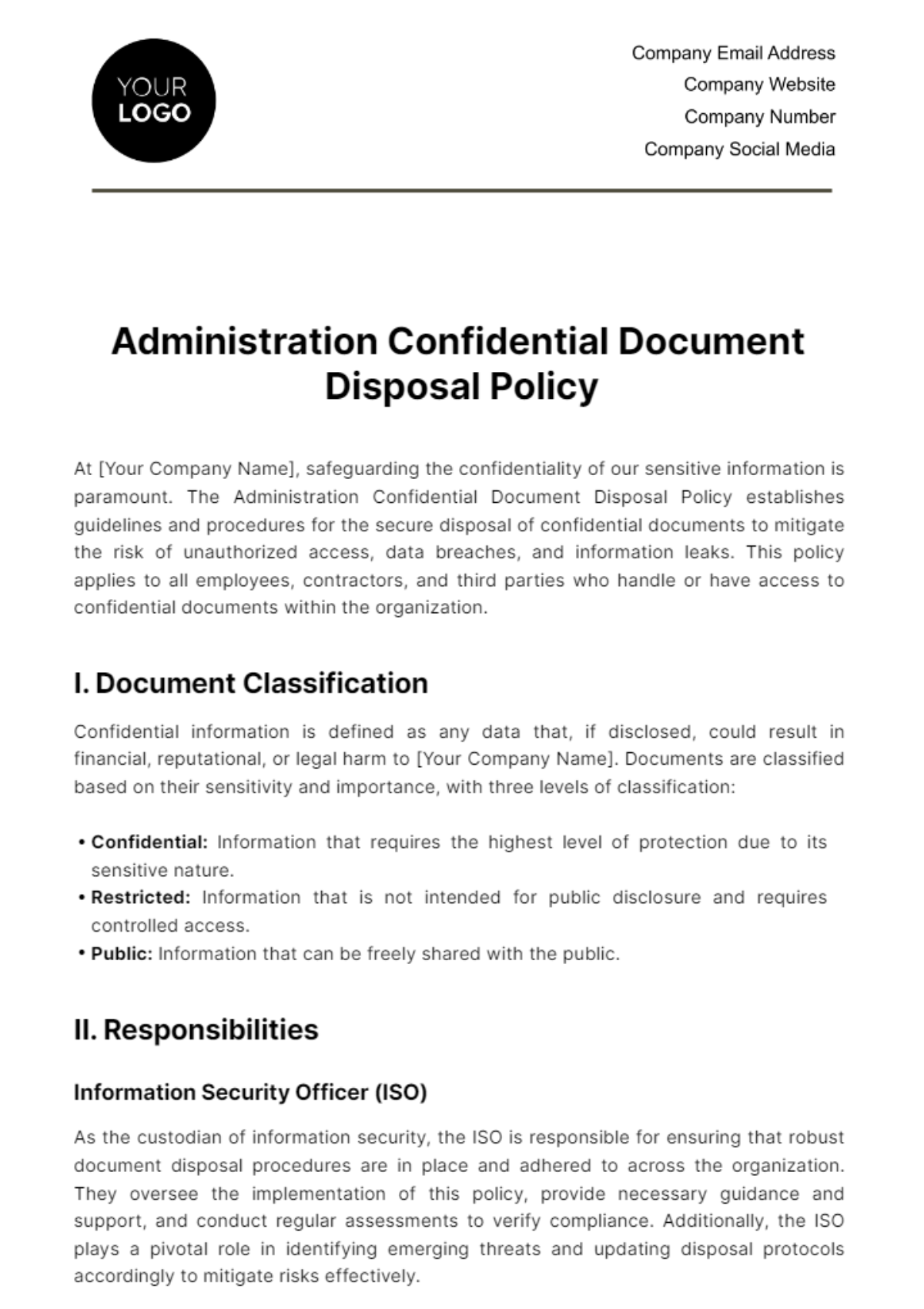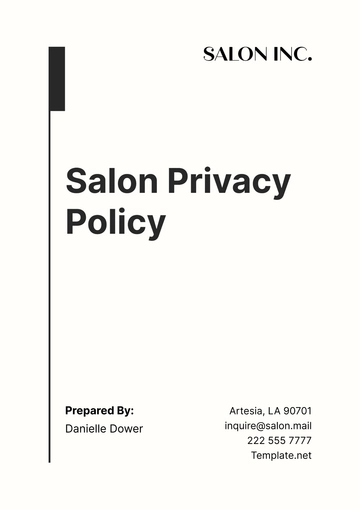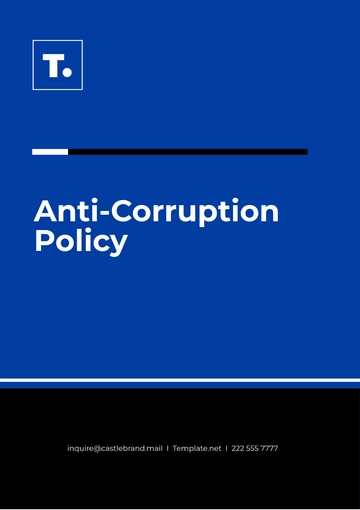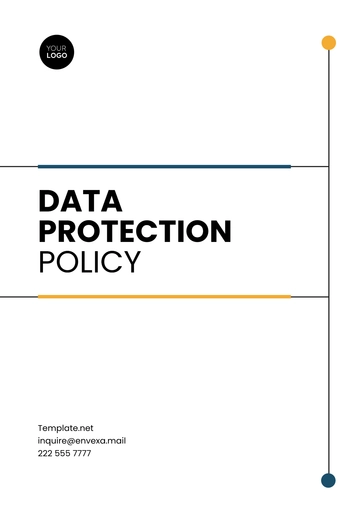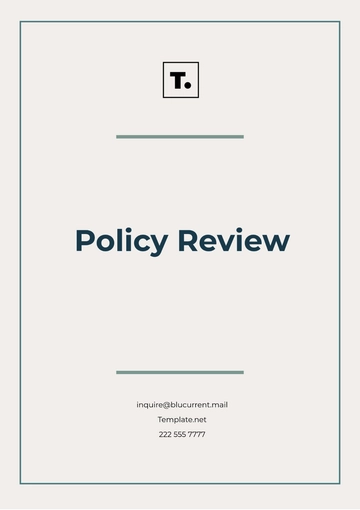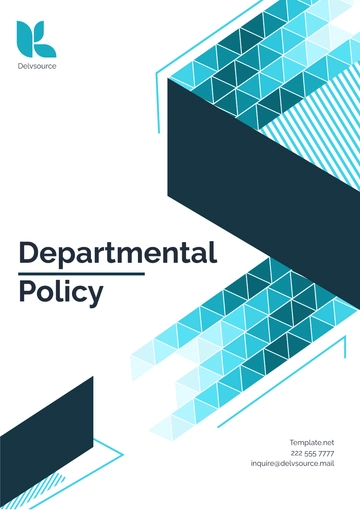Administration Confidential Document Disposal Policy
At [Your Company Name], safeguarding the confidentiality of our sensitive information is paramount. The Administration Confidential Document Disposal Policy establishes guidelines and procedures for the secure disposal of confidential documents to mitigate the risk of unauthorized access, data breaches, and information leaks. This policy applies to all employees, contractors, and third parties who handle or have access to confidential documents within the organization.
I. Document Classification
Confidential information is defined as any data that, if disclosed, could result in financial, reputational, or legal harm to [Your Company Name]. Documents are classified based on their sensitivity and importance, with three levels of classification:
Confidential: Information that requires the highest level of protection due to its sensitive nature.
Restricted: Information that is not intended for public disclosure and requires controlled access.
Public: Information that can be freely shared with the public.
II. Responsibilities
Information Security Officer (ISO)
As the custodian of information security, the ISO is responsible for ensuring that robust document disposal procedures are in place and adhered to across the organization. They oversee the implementation of this policy, provide necessary guidance and support, and conduct regular assessments to verify compliance. Additionally, the ISO plays a pivotal role in identifying emerging threats and updating disposal protocols accordingly to mitigate risks effectively.
Departmental Representatives
Each departmental representative acts as a liaison between their respective teams and the Information Security Office. They are tasked with disseminating information about document disposal procedures within their departments, addressing any queries or concerns, and promptly reporting any incidents or deviations from policy guidelines. By actively engaging with employees and promoting a culture of compliance, departmental representatives contribute significantly to the overall effectiveness of our document disposal practices.
Employees
Every employee is entrusted with the responsibility of handling confidential documents with utmost care and discretion. They are required to familiarize themselves with the document classification system, follow prescribed disposal methods diligently, and maintain the confidentiality of sensitive information at all times. Through their commitment to these responsibilities, employees play a vital role in safeguarding the organization's reputation and maintaining stakeholder trust.
III. Document Disposal Procedures
Secure Shredding
Confidential and restricted documents must undergo thorough shredding using cross-cut shredders, ensuring that no sensitive information remains intact. Regular maintenance and inspection of shredding equipment are essential to guarantee its effectiveness in preventing unauthorized access to discarded documents. By adhering to strict shredding protocols, we minimize the risk of data breaches and uphold the highest standards of information security.
Incineration
In situations where physical destruction is necessary, documents may be disposed of through secure incineration processes conducted under controlled conditions. Strict adherence to environmental regulations and safety protocols is paramount to minimize any potential hazards associated with incineration. By entrusting document destruction to certified vendors with established track records, we ensure the proper disposal of sensitive materials while mitigating environmental impact.
IV. Storage Guidelines
Confidential documents must be securely stored in designated areas equipped with locking mechanisms to restrict access to authorized personnel only. Access to these storage facilities should be monitored and logged to track any instances of unauthorized entry or tampering. Regular audits of storage areas, including physical inspections and digital surveillance, help maintain the integrity of our document storage practices and identify any potential vulnerabilities or weaknesses.
Training and Awareness
Employee training on document disposal procedures is a foundational element of our information security framework. Through comprehensive onboarding sessions and ongoing training initiatives, employees gain a thorough understanding of their roles and responsibilities in maintaining document security. Awareness campaigns, including newsletters, posters, and online resources, reinforce the importance of proper document disposal practices and empower employees to be vigilant against potential threats or breaches. By investing in continuous education and awareness, we foster a culture of accountability and collective responsibility for safeguarding sensitive information.
VI. Compliance and Monitoring
Regular audits and inspections are conducted to evaluate the effectiveness of document disposal procedures and identify areas for improvement. Internal audits assess adherence to policy guidelines, while external audits may be performed by independent assessors to ensure compliance with industry standards and regulatory requirements. The findings of these audits inform corrective actions and enhancements to our disposal protocols, ensuring that our practices remain robust and aligned with best practices.
Conclusion
Compliance with the Administration Confidential Document Disposal Policy is fundamental to maintaining the trust and integrity of [Your Company Name]. By embracing our individual and collective responsibilities outlined in this policy, we uphold the highest standards of information security and protect our organization against potential risks and threats. Through ongoing training, vigilant monitoring, and a commitment to continuous improvement, we reinforce our dedication to safeguarding confidential information and preserving the confidentiality of our stakeholders.
Administration Templates @ Template.net
